by James Ensing
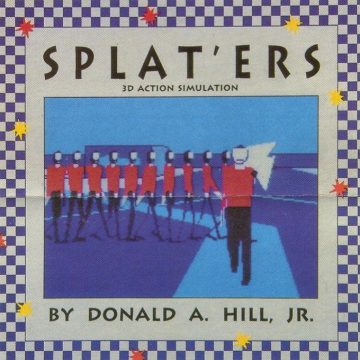
American Mac Cover
In the gaming world, rogue apostrophes are generally found in first person shooters with a Western fantasy theme, but SPLAT’ERS is one which has strayed from its natural habitat, being an incredibly innovative and equally rare FPS game from the early 90s. SPLAT’ERS is the brainchild of the late Donald A. Hill, Jr., a prolific lone indie developer for Apple systems. His output consists almost exclusively of flight and flight combat simulators, with SPLAT’ERS being one of the few exceptions; a paintball simulator.
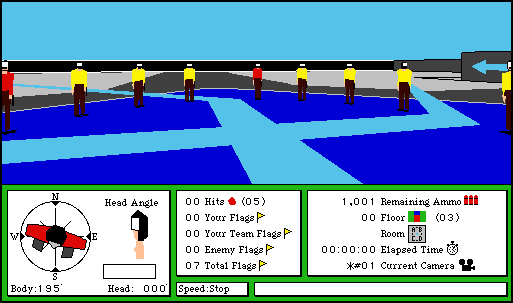
SPLAT’ERS (Macintosh)
The game is compatible with System Software 6 & 7 for Macintosh, running in monochrome on the former and 16 color mode on the latter. There are several optional tutorials included. These are very much necessary, as the controls are quirky and complex: the main source of confusion is that your character’s head and body can be moved separately, and must be aligned manually if you want to move in the direction that you are looking in. Simply getting around can be very difficult at first, as you wrestle with the mouse and keyboard to align your head and body respectively. The far left of the HUD shows a diagram of your character, viewed from above in a compass circle to help with this.
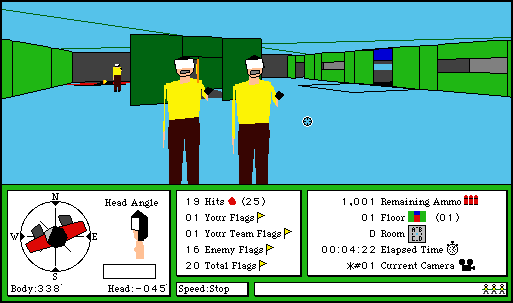
SPLAT’ERS (Macintosh)
There are also a large number of generally unnecessary functions, such as four separate buttons used to go forward, each at a different speed. Not to mention an additional key devoted to halting momentum; you can’t just take your finger off a button to stop. Increased complexity can add depth if implemented well, but sadly that’s not the case here: although the controls are more nuanced than in most modern FPS games, the increased range of options available are rarely very useful. Having said that, SPLAT’ERS does have one of the earliest – quite possibly the very first – implementation of two extremely important FPS control features that we now take for granted: crouching and mouse-look. Yes, mouse-look, three years prior to Marathon which is almost universally cited as the first game to contain this convention. In the screen shot below I’m looking downwards at a flag – note how the Head Angle diagram in the HUD has changed. Also note my character’s gigantic Adam’s Apple:
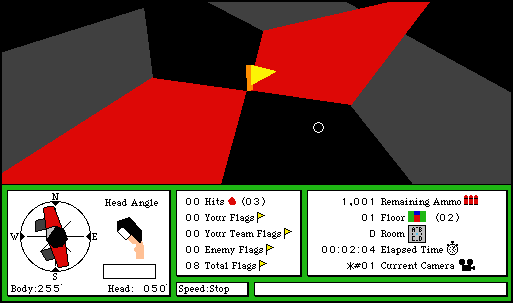
SPLAT’ERS (Macintosh)
After ploughing through the tutorials you’ll be ready to begin the game proper, which consists of Capture the Flag mode (another likely FPS first) and nothing else. There are two colour-coded teams, red shirts and yellow shirts, and Star Trek fans will be amused to find that you absolutely have to play on the red shirt team – being yellow simply isn’t an option. Before starting both teams gather at the top floor of the multi-storey arena, which is a safe zone, indicated by a giant cyan swastika on the floor for no apparent reason. They then decide who will go down into the structure first with the aid of a referee, who picks a random number and asks you to guess if it’s odd or even.
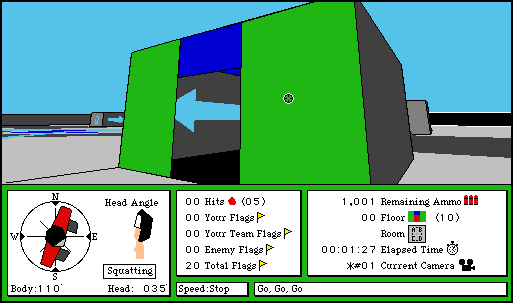
SPLAT’ERS (Macintosh)
Guessing correctly lets you choose to go down first or second, and whichever team remains behind has to wait a while before entering. If you are wrong the other side get to make the decision, and almost always opt to descend first, but sometimes let you go ahead. If you are forced to wait, one of the most unusual features in SPLAT’ERS will come in handy: at any time you can switch camera angles to spy through the eyes of any other player. This also makes SPLAT’ERS one of the first FPS game to feature multiple camera angles.
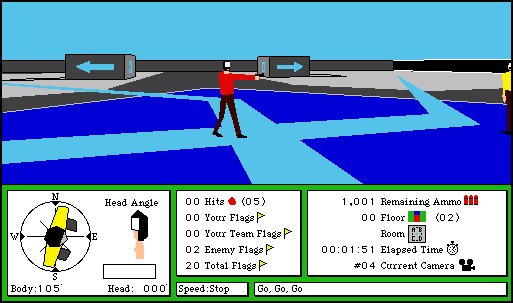
SPLAT’ERS (Macintosh)
When you’re allowed to go down, you must make your way to a lift (the rooms with arrows on in the screen shot above) and then choose which floor you want to visit. After this it’s business as you would expect: infiltrate the various floors, shoot yellow shirts and avoid getting hit yourself, collect all the flags and return them to the safe zone to win. When a player is hit a certain number of times by someone on the opposite team, they will be unable to move and shoot for a while. This is shown by their head suddenly detaching from their shoulders and violently rocketing into the air, spinning furiously, after which it is magnetised to their groin, where it will stay until they are allowed to play again. This is genuinely what happens. Once they are back in the game their head levitates back onto their shoulders and attaches to their body once more.
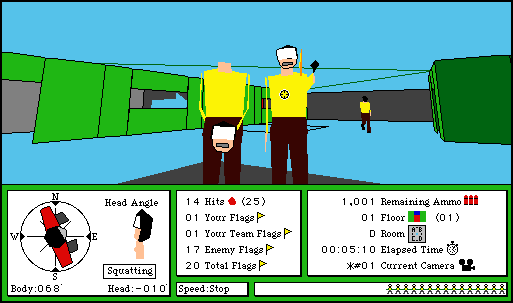
SPLAT’ERS (Macintosh)
Graphically the game is very impressive for the time of its release, especially considering that it was entirely coded by one person, with all characters and environments being made of non-shaded single colour polygons. There is no actual lighting, but a few rooms simulate being selectively lit by making all objects in some parts completely black. These are also the most interesting to navigate, as obstacles in the black areas can of course only be seen if something bright is behind them, forcing you to think creatively about your route and carefully examine your surroundings
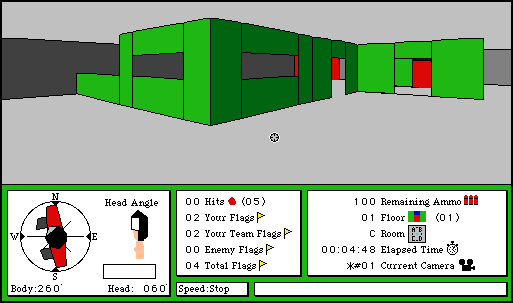
SPLAT’ERS (Macintosh)
Sadly there are no inclines, so looking up and down is rarely necessary other than when you need to pick up a flag: they can’t be collected unless you stop absolutely directly above them, which is very hard to judge without at least a quick glance down. The game also features persistent bullet holes, or paint splotches to be precise (yet another likely innovation): up to 20 are kept in memory, after which the first one made will disappear so that the latest one can be displayed, and so on. Behold my painstakingly created opus:
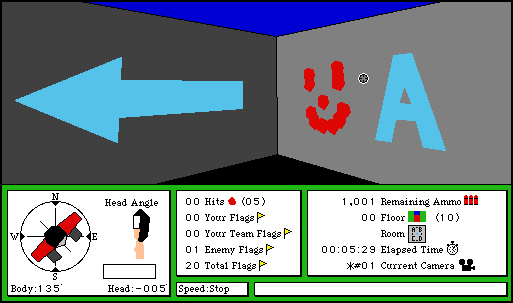
SPLAT’ERS (Macintosh)
Aurally the situation is less than stellar, with absolutely no music and few sound effects, all of which are low quality. It gets the job done, but is clearly one of the weaker areas of the game. Enemy AI is very simple, and although you can customise aspects of it to adjust the difficulty of matches, your opponents are only a real threat in large numbers. The game would greatly benefit from a multiplayer mode to add some better competition, but is sadly single player only. This is a real shame, especially since you can actually save replays. Is that another FPS first? But despite some missed opportunities and needlessly complex controls, SPLAT’ERS can be a surprisingly enjoyable game, and all truly dedicated FPS fans owe it to themselves to experience this oddity if only to see how ground-breaking and strange it is.
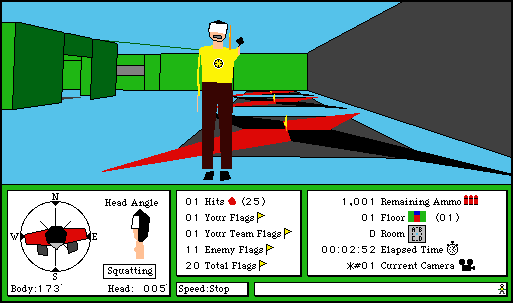
SPLAT’ERS (Macintosh)
Obtaining a physical copy of SPLAT’ERS is very difficult, due to low production quantities rather than high demand, but if you do manage to hunt one down it shouldn’t be very expensive. There are two versions that I know of: the original on floppy disk (v1.01) from 1991, and a later update (v1.05) found on the Simulator CD Pack compilation published by Bullseye Software in 1994. SPLAT’ERS v1.05 is actually very easy to find online, and can be emulated perfectly with popular Macintosh emulators Mini vMac and Basilisk II. Mini vMac does not support System Software 7 so everything will be monochrome, but it’s significantly easier to make the game work properly on this emulator, so if you just want to have a quick dabble this is actually the best choice. Basilisk II is the best way to experience it in color, but will require a lot of coaxing to get things running smoothly. Happy SPLAT’ERing!

